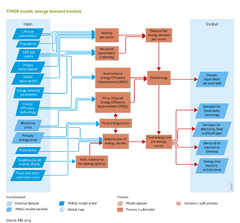Energy demand/Data uncertainties limitations: Difference between revisions
mNo edit summary |
Sluisveldvm (talk | contribs) No edit summary |
||
| Line 5: | Line 5: | ||
==Data, uncertainty and limitations== | ==Data, uncertainty and limitations== | ||
===Data=== | ===Data=== | ||
The energy demand module has been calibrated for the | The energy demand module has been calibrated for the 1971–2015 period in order to reproduce historical trends in fuel and electricity use. Using the historical input data on population and value added and the calculated energy prices as given, other drivers and model parameters were varied systematically within the range of values derived from the literature, in order to improve the fit ([[Van Ruijven et al., 2010a]]; [[Van Ruijven et al., 2010b]]). | ||
The primary data source on energy use was the International Energy Agency (IEA). These data were complemented with data from other sources, such as | The primary data source on energy use was the International Energy Agency (IEA). These data were complemented with data from other sources, such as total material demand and production, travel demand, etc., as described in the (key) references of the different model components. | ||
===Uncertainties=== | ===Uncertainties=== | ||
The main uncertainties in modelling energy demand relate to the interpretation of historical trends, | The main uncertainties in modelling energy demand relate to the interpretation of historical trends, such as the existence of saturation levels and the potential for efficiency increases. The representation in TIMER is based on the assumption that demand for energy services tends to become saturated at some point. This is based on physical considerations and historical trends in sectors, such as residential energy use. However, economic models assume that income and energy use remain coupled, often even at constant growth elasticities. Secondly, insufficient data is available to fully understand (historic) energy demand trends on which global energy models can be calibrated. Various methods have been developed to study the implications of different model calibrations, which have previously been applied to the transport and residential submodules ([[Van Ruijven et al., 2010a]]; [[Van Ruijven et al., 2010b]]) | ||
===Limitations=== | ===Limitations=== | ||
The main limitations of the [[TIMER]] energy demand model are listed in the introduction to the model. A critical factor in modelling energy demand is the level of detail, given the large number of relevant technologies. TIMER uses an intermediate approach, in which some key technologies are modelled explicitly, and others are included implicitly. For more detailed estimates of the potential of energy efficiency, it would be more appropriate to use a different model. | The main limitations of the [[TIMER]] energy demand model are listed in the introduction to the model. A critical factor in modelling energy demand is the level of detail, given the large number of relevant technologies. TIMER uses an intermediate approach, in which some key technologies are modelled explicitly, and others are included implicitly. For more detailed estimates of the potential of energy efficiency, it would be more appropriate to use a different model. Similar for the complexity of supply chains: all demand sectors represent individual sectors that co-exist in parallel without exchange of information (other than fuel demand, fuel price), meaning that e.g. the residential and the cement sectors are not linked but are treated separately. | ||
</div> | </div> | ||
Latest revision as of 16:17, 22 May 2019
Parts of Energy demand/Data uncertainties limitations
| Component is implemented in: |
|
| Related IMAGE components |
| Projects/Applications |
| Key publications |
| References |
Data, uncertainty and limitations
Data
The energy demand module has been calibrated for the 1971–2015 period in order to reproduce historical trends in fuel and electricity use. Using the historical input data on population and value added and the calculated energy prices as given, other drivers and model parameters were varied systematically within the range of values derived from the literature, in order to improve the fit (Van Ruijven et al., 2010a; Van Ruijven et al., 2010b).
The primary data source on energy use was the International Energy Agency (IEA). These data were complemented with data from other sources, such as total material demand and production, travel demand, etc., as described in the (key) references of the different model components.
Uncertainties
The main uncertainties in modelling energy demand relate to the interpretation of historical trends, such as the existence of saturation levels and the potential for efficiency increases. The representation in TIMER is based on the assumption that demand for energy services tends to become saturated at some point. This is based on physical considerations and historical trends in sectors, such as residential energy use. However, economic models assume that income and energy use remain coupled, often even at constant growth elasticities. Secondly, insufficient data is available to fully understand (historic) energy demand trends on which global energy models can be calibrated. Various methods have been developed to study the implications of different model calibrations, which have previously been applied to the transport and residential submodules (Van Ruijven et al., 2010a; Van Ruijven et al., 2010b)
Limitations
The main limitations of the TIMER energy demand model are listed in the introduction to the model. A critical factor in modelling energy demand is the level of detail, given the large number of relevant technologies. TIMER uses an intermediate approach, in which some key technologies are modelled explicitly, and others are included implicitly. For more detailed estimates of the potential of energy efficiency, it would be more appropriate to use a different model. Similar for the complexity of supply chains: all demand sectors represent individual sectors that co-exist in parallel without exchange of information (other than fuel demand, fuel price), meaning that e.g. the residential and the cement sectors are not linked but are treated separately.
